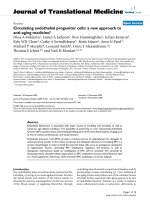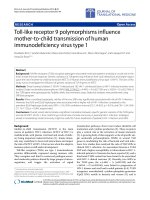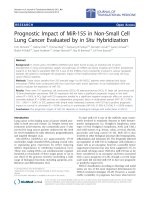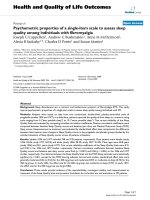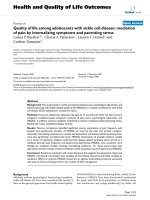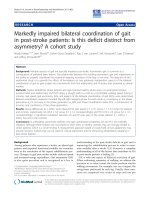báo cáo hóa học:" Neglected simultaneous bilateral femoral neck fractures secondary to narcotic drug abuse treated by bilateral one-staged hemiarthroplasty: a case report" pptx
Bạn đang xem bản rút gọn của tài liệu. Xem và tải ngay bản đầy đủ của tài liệu tại đây (2.32 MB, 4 trang )
Hootkani et al. Journal of Orthopaedic Surgery and Research 2010, 5:41
/>Open Access
CASE REPORT
© 2010 Hootkani et al; licensee BioMed Central Ltd. This is an Open Access article distributed under the terms of the Creative Commons
Attribution License ( which permits unrestricted use, distribution, and reproduction in
any medium, provided the original work is properly cited.
Case report
Neglected simultaneous bilateral femoral neck
fractures secondary to narcotic drug abuse treated
by bilateral one-staged hemiarthroplasty: a case
report
Alireza Hootkani, Ali Moradi and Ehsan Vahedi*
Abstract
Simultaneous bilateral femoral neck fractures are extremely rare and associated with various conditions. Up to now
Most cases had correlations with major trauma, repetitive minor trauma, seizure, parathyroid or renal dysfunction, anti-
epileptic medications, seizure, etc. A 28-year-old addict man referred to us with a 10-year history of narcotic drug abuse
and history of 8 months bilateral groin pain. He admitted with displaced bilateral femoral neck fracture. Because of long
duration of this condition and osteonecrosis revealed on bone scan, one-staged bilateral hip hemiarthroplasty was
done. A good function was noted after surgery to 4-month follow up. Up to now, have not be founded in the literature
that a case of bilateral femoral neck fracture associated with narcotic drug abuse.
Because of negative effects of opium or smoking on bone tissues, a simple bone pain should aware us about the risk of
stress or fatigue fracture.
Background
Simultaneous bilateral femoral neck fractures are
extremely rare and have been associated with high-
energy trauma [1], repetitive minor trauma, abnormal
anatomy [2], seizure [3-9], electrical injury, electrocon-
vulsive therapy, primary or secondary bone diseases such
as osteomalacia [10], hyperparathyroidism [11], chronic
renal failure [12], or severe osteoporosis especially after
corticosteroid or other corticosteroid-like drug therapy.
Different procedures have reported in the literature for
treatment of bilateral femoral neck fracture include in
situ fixation, open reduction and internal fixation, open
fixation with valgus intertrochanteric osteotomy [13] and
hemi or total hip arthroplasty in one [14] or two-staged
operations.
The complications include: non-union, delayed union
and shortening. Femoral head osteonecrosis and coxa
vara can be avoided with correct treatment.
In this report, we present a case of bilateral femoral
neck fractures with prolonged history of narcotic drug
abuse, treated by bilateral hemiarthroplasty. We did not
found any previously recognized underlying risk factors
for stress fracture.
Case presentation
A 28-yr-old addict man was referred to our institution
with an 8 month history of chronic pain in both groins
aggravated by weight bearing sometimes keeping him
awake at night. He had previously normal activities with-
out specific sport or job program. By disease onset, His
activities were restricted because of the pain and
decreased range of motion. About 4 months before oper-
ation, the patient was visited by a physician who took a
plain pelvic radiograph which revealed displaced left and
non-displaced right femoral neck stress fracture (Fig-1).
After 8-month, because of low socio-economic state
and not appropriate follow-up by him, finally, the patient
was referred to us with displaced bilateral hip fractures
(Fig-2).
On examination, his weight was 65 kilograms and both
active and passive motions were painful and restricted.
Active straight leg raise was not possible on either side.
* Correspondence:
1
Orthopaedics division, Emamreza Medical Center, Mashhad University of
Medical Sciences, Mashhad, Iran
Full list of author information is available at the end of the article
Hootkani et al. Journal of Orthopaedic Surgery and Research 2010, 5:41
/>Page 2 of 4
No limb-length discrepancy was observed because of
symmetrical nature of the deformity.
There was no evidence of any underlying metabolic or
endocrine disease affecting the bone strength in physical
examination or family history.
In laboratory tests, CBC, ESR, alkaline phosphatase,
serum calcium, phosphorus and serum total protein lev-
els were normal. Normal Parathyroid, thyroid, renal,
gonadal and liver function tests were detected. 24-hour
urinary excretion for calcium and phosphorus was also
within normal ranges.
Because of long period of immobilization and lesser
activities, which decreased bone density, we did not con-
sider bone densitometry for him.
Skeletal bone scan with TC-99m showed no other
abnormal findings except bilateral femoral head osteone-
crosis and bilateral femoral neck fracture (Fig-3).
Surgery was performed using general anesthesia with
the patient lateral on a conventional operating table for
both right and left hips at one section choosing postero-
lateral minimal incision approach. The cartilage of the
acetabulum was intact and heads of the femurs were
decided to be replaced with bipolar prosthesis (Fig-4).
During operation, it was noted that bone ends at the frac-
ture site was extremely sclerotic and difficult to penetrate
with instruments. A biopsy showed no evidence of meta-
bolic bone disease and osteonecrosis was reported. The
postoperative period was uneventful. Quadriceps exer-
cises and pain free movement of both hips were permit-
ted from the first post operative day. Then, the patient
was permitted to bear weight.
The patient had normal range of motion in both hips
and was capable of doing daily activities after 24 weeks of
follow up.
Discussion
Hip Stress fractures of most frequently involve the medial
aspect of femoral neck. They are termed fatigue fracture
in patients who have normal bone but are exposed to
excessive mechanical stress, such as many seen in athletes
Figure 1 Radiograph taken 4 months before operation demonstrates displaced left femoral neck stress fracture and non-displaced right
femoral neck stress fracture.
Hootkani et al. Journal of Orthopaedic Surgery and Research 2010, 5:41
/>Page 3 of 4
Figure 2 Radiograph taken before operation demonstrates displaced bilateral femoral neck stress fractures.
Figure 3 Skeletal bone scan with TC-99m showed no other ab-
normal findings except bilateral femoral head osteonecrosis and
bilateral femoral neck fracture.
Figure 4 Radiograph taken after operation demonstrates re-
placement of left and right hip with bipolar prosthesis.
Hootkani et al. Journal of Orthopaedic Surgery and Research 2010, 5:41
/>Page 4 of 4
and army recruits, and they are termed insufficiency frac-
tures in patients who have abnormal bone subjected to
normal stress.
The remarkable characteristics of this case include
simultaneous, bilateral, displaced fractures with no evi-
dence of underlying pathologic factor; suspicious rela-
tionship with narcotic drug abuse and simultaneous
operation of both hips in one section with minimal inci-
sion approach.
In this case, stress fractures of femoral neck were prob-
ably related to 10 year history of drug abuse. By further
abuse, the pain decreased and continuity of activities
aggravated the fracture and ultimately complete bilateral
femoral neck fracture occurred.
Many procedures have been reported in the literature
for treatment of bilateral femoral neck fractures. These
include lag screw or dynamic hip screw fixation [6-
8,15,16], pedicle bone grafting [10], and a combination of
these. In this case, because of the complete displacement
and osteonecrosis and high risk of nonunion (23%-43%)
[17-19], we decided to replace the femoral head instead of
open reduction and internal fixation, and young age of
the patient did not change our decision.
To our knowledge, this is the first report in the English
literature of bilateral neglected displaced femoral neck
fractures in which the only predisposing factor was nar-
cotic drug abuse.
Conclusions
The negative effects of smoking or opium on bone tissues
or bone healing processes were well recognized. Also,
narcotic agents diminish signs and symptoms of any
painful condition affecting the bones. Because of various
risk factors predisposing many people to development of
stress fractures, we suggest that each patient who com-
plaints of prolonged bone pain and has positive history of
opium abuse, should be considered an important under-
lying bone disease such as stress fracture until proven
otherwise.
Consent
Written informed consent was obtained from the patient
for publication of this case report and any accompanying
images. A copy of written consent is available for review
by the editor-in-chief of this journal.
Competing interests
The authors declare that they have no competing interests.
Authors' contributions
AH performed part of the literature review, examined the patient and operated
him. Also he had given final approval of the version to be published and gener-
ally supervised this report. AM also performed part of literature review, partici-
pated in operation and conceived the idea of present study and case report
presentation. EV contributes in literature review, analyzed the data and
involved in editing the manuscript. All authors have read and approved the
final manuscript.
Author Details
Orthopaedics division, Emamreza Medical Center, Mashhad University of
Medical Sciences, Mashhad, Iran
References
1. Schroder J, Marti RK: Simultaneous bilateral femoral neck fractures: case
report. Swiss Surg 2001, 7:222-224.
2. Annan IH, Buxton RA: Bilateral stress fractures of the femoral neck
associated with abnormal anatomy: a case report. Injury 1986,
17:164-166.
3. Funk L, Faux JC: Bilateral combined femoral neck and acetabular
fractures due to cerebro-vascular ischemic induced convulsion. Eur J
Orthop Surg Traumatol 1998, 8:145-146.
4. Gur S, Yilmaz H, Tuzuner S: Fractures due to hypocalcemic convulsion.
Int Orthop 1999, 23:308-309.
5. Kause J, Parr MJ: Bilateral subcapital neck of femur fractures after
eclamptic seizures. B J Anesth 2004, 92:590-592.
6. Powell HDW: Simultaneous bilateral fractures of the neck of the femur.
J Bone Joint Surg 1960, 42(B):236-252.
7. Rahman MM, Awada A: Bilateral simultaneous hip fractures secondary
to an epileptic seizure. Saudi Med J 2003, 24:1261-1263.
8. Suh KT, Kang DJ, Lee JS: Bilateral intertrochanteric fractures after
surgical treatment of bilateral femoral neck fractures secondary to
hypocalcemic convulsions with chronic renal failure: a case report and
review of the literature. Arch Orthop Trauma Surg 2006, 126:123-126.
9. Tompkins GS, Henderson RC, Peterson HD: Bilateral simultaneous
fractures of the femoral neck: case report. J Trauma 2002, 30:415-1416.
10. Chadha M, Balain B, Maini L: Spontaneous bilateral displaced femoral
neck fractures in nutritional osteomalacia-a case report. Acta Orthop
Scand 2001, 72:94-96.
11. Chen CE, Kao CL, Wang CJ: Bilateral pathological femoral neck fractures
secondary to ectopic parathyroid adenoma. Arch Orthop Trauma Surg
1998, 118:164-166.
12. Madhok R, Rand JA: Ten year follow-up study of missed, simultaneous,
bilateral femoral-neck fracture treated by bipolar arthroplasties in a
patient with chronic renal failure. Clin Orthop 1993, 291:185-187.
13. Narender M K, Rajesh R, Gulia AD D, Roop S: Valgus intertrochanteric
osteotomy in neglected simultaneous, bilateral, displaced subcapital
femoral neck fractures in an epileptic pregnant woman. Current
Orthopedic Practice 2009, 20:461-463.
14. Grimaldi M, Vouaillat H, Tonetti J, Merloz P: simultaneous bilateral
femoral neck fractures secondary to epileptic seizures: treatment by
bilateral total hip arthroplasty. Rev Chir Orthop Traumatol 2009,
95(7):555-7.
15. Haddad FS, Mohanna PN, Goddard NJ: Bilateral femoral neck stress
fractures following steroid treatment. Injury 1997, 28:671-673.
16. Kalci A, Yanat AN, Sevinc T: Insufficiency fractures of both femoral necks
in a young adult caused by osteoporosis: a case report. Arch Orthop
Trauma Surg 2008, 128(8):865-8.
17. Jackson M, Learmonth ID: The treatment of nonunion after
intracapsular fracture of proximal femur. Clin Orthop 2002, 399:119-128.
18. LaVelle DG: Fractures and dislocations of the hip. Edited by: Canale ST.
Campbell's Operative Orthopedics. Philadelphia: Mosby-Elsevier;
2008:3237-3308.
19. Lu-Yao GL, Keller RB, Littenberg B: Outcomes after displaced fractures of
the femoral neck: a meta-analysis of one hundred and six published
reports. J Bone Joint Surg 1994, 76(A):15-25.
doi: 10.1186/1749-799X-5-41
Cite this article as: Hootkani et al., Neglected simultaneous bilateral femoral
neck fractures secondary to narcotic drug abuse treated by bilateral one-
staged hemiarthroplasty: a case report Journal of Orthopaedic Surgery and
Research 2010, 5:41
Received: 1 May 2010 Accepted: 25 June 2010
Published: 25 June 2010
This article is available from: 2010 Hootkani et al; licensee BioMed Central Ltd. This is an Open Access article distributed under the terms of the Creative Commons Attribution License ( which permits unrestricted use, distribution, and reproduction in any medium, provided the original work is properly cited.Journal of Orthopaedic Surgery and Research 2010, 5:41



